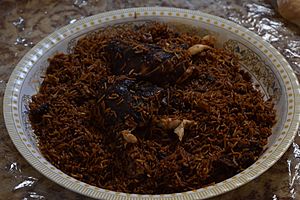Mahmous facts for kids

Mahmous served with fried chicken wings
|
|
| Place of origin | Qatif |
|---|---|
| Region or state | Qatif, al-Hasa, Bahrain |
| Serving temperature | Hot |
| Main ingredients | Rice, onion |
Mahmous (Arabic: محموص) is a special rice dish from the Middle East. It is very popular in places like Qatif and al-Hasa in Saudi Arabia. You can also find it in Bahrain. The main ingredients for Mahmous are rice and onion.
This dish might have started a long time ago, before oil was discovered in Saudi Arabia. Back then, people in Qatif were not very rich. They could not always afford to cook with chicken, fish, or meat. So, they used onions instead. Mahmous is often dark in color. It is also easy to make with simple, cheap ingredients. Because of this, it is often shared during Ashura. This helps show a feeling of sadness during that time.
Contents
What Does "Mahmous" Mean?
The name Mahmous comes from an Arabic word for roasting. It is like how hummus is made from roasted chickpeas. But for Mahmous, it refers to roasting onions.
The name comes from how red onions are cooked. They are sautéd until they turn a dark, crispy, caramelized color. This happens at the bottom of a pot with oil. Then, meat and rice are added.
Where Did Mahmous Come From?
No one knows exactly when or where Mahmous was first made. But most people think it started on Tarout Island or in Qatif. Long ago, the southern shores of the Persian Gulf had lots of water. This was perfect for growing plants that needed a lot of water, like onions.
The oldest records show that a place called a hussainiya first made Mahmous. This was a special hall for Shia ceremonies. It belonged to Sheikh Mansour al-Saif (1876-1943) on Tarout. His family still hosts holidays and funerals today. Cooking Mahmous was once done by both men and women. Now, it is mostly women who prepare it. They still roast the onions over wood, often palm fronds. Even though gas is now common, some still use traditional methods.
Why Was Mahmous Created?
It is not fully clear why Mahmous was first made. Here are some ideas:
- Some historians say it was not just because people were poor in Tarout. They believe the dark color of the roasted onions is important. It connects the dish to the color of Ashura. This was the only time Mahmous was traditionally made in Qatif.
- Others think that people in Tarout were poor fishers. They did not have refrigerators. So, they could not easily cook meat for the ten-day Ashura festival. Onions were easy to find and could be used instead.
Making Mahmous
Mahmous is made by peeling onions and chickpeas. The cooking usually starts after the sunset prayer. This way, it is ready after the noon prayer the next day. In the past, people started preparing two months before Muharram. This was during the month of Shawwal. Women in villages would gather to clean large amounts of rice, sometimes around 140 bags!
Some old traditions are still used today by some hosts. This includes roasting over firewood or palm fronds. They also place the cooked rice in baskets made from palm fronds. Weaving these baskets is a local art called Al-Khous.
Sharing Mahmous with the Community
Young people and older people work together to chop onions. They fill dishes with Mahmous for visitors. They also share it with homes and people passing by in the streets. This is especially true for those who are poor. It is very common to pack Mahmous for ceremonies during the mourning of Muharram. It is also sent to other places in Qatif towns.
Over time, cooking Mahmous has changed. It used to be a single person's job. Now, it is a group effort by volunteers. The hosts provide things like pots, cooking tools, and machines for peeling onions or cutting meat. These are set up in squares and mosques near a hussainiya. Hosts often serve other foods too. These include rice-flour qatayef (folded pancakes). They also offer hot drinks like coffee and tea with cinnamon sugar syrup or milk.
Local people in Qatif often help the youth serving groups. For example, the Mansour Al-Saif Hussainiya is one of the oldest and most famous hosts. They serve about 800 dishes a day during Ashura in Tarout's Al-Deyrah neighborhood. Many important people in the region help supervise the cooking. The Al-Ghawi family in Qatif has made the dish for the Al Bahari neighborhood since before 1980. People come to their family house early in the morning to help. About fifty women from the area help in one section. The men work in another part of the house.
People from different groups, like the Sunnis of Zour, Darin, and Anak, join the Shiites of Tarout and Qatif. Sometimes, people from Tarout island send pots of Mahmous to Zour and Darin. Families there wait for them every year.
In Bahrain, Sunnis and Shiites have lived close to each other for a long time. Many Sunnis grew up in areas where most people were Shiite, like in the cities of Manama and Muharraq. So, it was common for Sunni families living near the husseiniyas to help prepare the Ashura meals. This shows how people from different groups can come together and share traditions.

